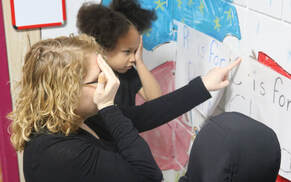|
S.M.A.R.T. Spaces As we’ve worked with S.M.A.R.T. educators and programs, we’ve noticed there are some activities are important to monitor. Helicopter Spins and Vision activities may seem like they require the least amount of supervision, but actually the opposite is true!  When monitoring Helicopter Spins keep these things in mind: 1) Some students tend to spin slowly – over the course of the year they should build up speed so they should be spinning faster now with less than a month to go. 2) Students may not spin the whole time (15 seconds) and/or stop the whole time (15 seconds) – to maximize the stimulation, and therefore benefit, it is important to spin for 15 seconds and stop for 15 seconds. 3) Some students like to dance or walk in circles – doing so does not provide the optimal environment for stimulation, encourage students to spin in a circle. We love to use Helicopter Spins as a whole group brain break activity. It is easy to monitor and it helps get the wiggles out so students can focus again. Do your students like to rush through Tactile Trackers or Wagon Wheels if you’re not right by them? We’ve noticed most students rush though by only covering one eye or not covering either eye. Vision activities are best done in a small group (3-5 students), so you can monitor what is happening with the eyes. Having a teacher there to monitor and/or model ensures students are doing the activities correctly and the time investment is worth every second.  References: Helicopter Spins S.M.A.R.T. Pre-K CORE Guide pages 35-36 S.M.A.R.T. Curriculum Guide pages 44-46 Tactile Trackers and Wagon Wheels S.M.A.R.T. Pre-K CORE Guide pages 64-66 S.M.A.R.T. Curriculum Guide pages 148-150 S.M.A.R.T. at Home S.M.A.R.T. teachers share information about the program with parents. This month’s One S.M.A.R.T. Teacher sends home a quarterly newsletter that includes information and pictures that show S.M.A.R.T. in action. Click here to read the newsletter! She shares about the activities students are doing in S.M.A.R.T. and includes information about what each activity supports. Parents often wonder what their child is doing in S.M.A.R.T. and how those movements help support learning readiness, so sharing this information through a newsletter is a very smart idea! Check out her Spring Pre-K S.M.A.R.T. News! Time Saving Tips Save time, save money! We know teachers are generally short on both near the end of the school year, so we have come up with a game to play at the dollar store that we call “How do I make this S.M.A.R.T.?” During our most recent dollar store adventure we came upon small pocket charts and had a light bulb moment! Why not use pocket charts for Learning Ladders?! They’re easy to switch, so instead of making new Learning Ladders every couple weeks, you can just switch the order, instant change! Plus you probably already have content to use in the pockets like math facts, spelling words, or state capitals. If you have a S.M.A.R.T. Course in your classroom, and already use pocket carts for these items, why not use them during the rotation? Just make sure the movement you use (ex. Rebounder) is located near the now charts turned Learning Ladders. When you do, please share it with us! References: S.M.A.R.T. Pre-K MORE Guide pages 108-109 S.M.A.R.T. Curriculum Guide pages 246-247 (note: you can use content beyond numbers) That's One S.M.A.R.T. Teacher! Many early childhood programs have transportation unit. Carol Sullivan, One S.M.A.R.T. Teacher from Kasson-Mantorville, has shared her clever ideas involving a car race theme. She uses “stop” and “go” cards in an AB pattern within the Slap Track and has applied her knowledge about the importance of vision to a racetrack. Carol uses Windshield Wipers as written in the S.M.A.R.T. Pre-K MORE Guide (pages 74-75) and encourages has her students to stay low while doing the Alligator Crawl by using a “car wash.” Carol’s students love the theme and we’re so glad she shared her great ideas so we could pass them on to you!
0 Comments
Leave a Reply. |
AuthorSCheryl Smythe Archives
May 2024
|





 RSS Feed
RSS Feed